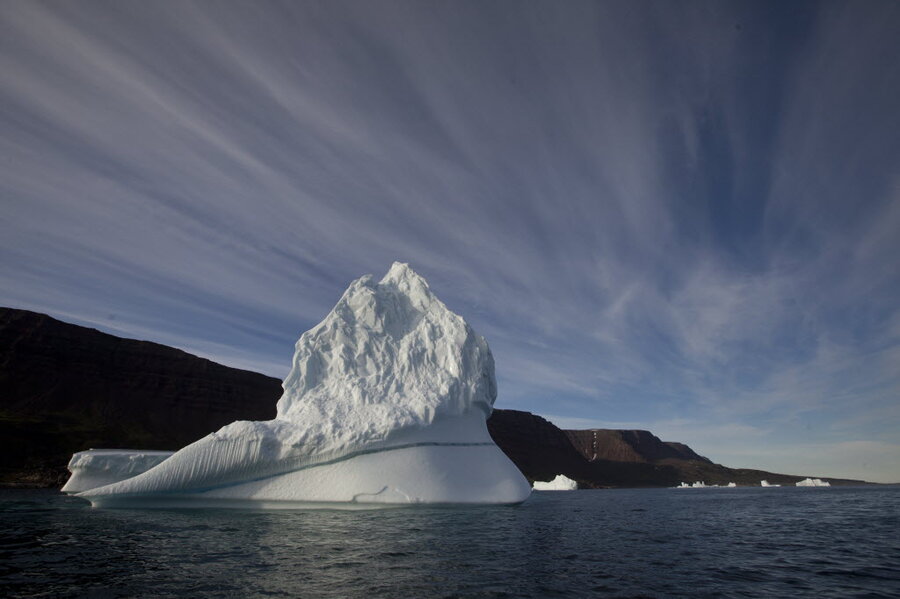Arctic ice continues to thin, and thin, European satellite reveals
Loading...
The thickness of the Arctic’s ice was whittled to a new winter low, according to data from the European Space Agency’s CryoSat mission. The ice’s volume, less than 15,000 cubic km between March and April, is a new data point in the long chronicle of Arctic ice decline, a process that scientists expect could be catastrophic for the planet.
The news from the ESA comes days after scientists reported that the ice’s decline this summer was less dramatic than the shrinkage during last year’s summer minimum. Rather than marking the resurgence of the Arctic ice, as some British newspapers have erroneously reported, the smaller-than-expected decline in breadth is understood by scientists as a small blip in what is otherwise a long-term ebbing of the ice.
And just as the ice is becoming less extensive, it is also becoming thinner – a trend that scientists point to as the most indicative sign that climate change is taking a toll on the Arctic.
CryoSat is the second iteration of the ESA’s CryoSat mission, after the first satellite was destroyed during launch in 2005 and was replaced with CryoSat-2. The satellite has been in low Earth orbit since 2010, where it has over three consecutive years taken measurements of the Arctic ice using an interferometric radar altimeter, a highly sophisticated instrument that assesses the thickness of the ice based on radar data about the altitude of the spacecraft.
The data, gathered between October 2010 to April 2013, has shown that the Arctic’s ice is becoming leaner and leaner, and has also underpinned exacting research on just where, when, and how the ice is shedding mass.
“From the satellite’s measurements we can see that some parts of the ice pack ice have thinned more rapidly than others, but there has been a decrease in the volume of winter and summer ice over the past three years,” Andrew Shepherd, a professor of the University of Leeds, told the audience at the Living Planet Symposium in Edinburgh, Scotland, on Wednesday.
The overall decline in the thickness of span of the Arctic ice has at times been heralded as a boon for certain economic sectors and the countries tied to them. Lloyd's of London, an insurance market, has projected that investment in the region could reach US $100 billion within ten years, as investors rush to a region rich in what is believed to be 30 percent of the world's undiscovered gas, as well as about 13 percent of its untapped oil. Meanwhile, the ice’s more extreme declines during the summer months have also turned the region into a viable – and profitable – route for shipping vessels.
All those possible profits have spurred heated debates in the Arctic Council about just who owns this region flush with oil and gas, and ribbed with new trade routes. And those debates have in turn furnished other debates about how even more fossil fuel burning might accelerate the pace of climate change and Arctic ice melt.
That’s bad news for harp seals and polar bears, whose lifecycles and ecosystems have been thrown out of balance as the ice ebbs underfoot. As early as 2005, the New York Times noted that the melt has also upended the lives of the Nordic peoples that call the ice home, as water laps away at the coasts that once supported their communities.
And the unabated melt is also bad news for the entire planet. Melting Arctic ice is not just a byproduct of climate change – scientists point out that is also helping to accelerate it. That’s because as ice cover wanes in the Arctic, less sunlight is reflected off the ice. Instead, it is absorbed into the ocean, which warms and then alters weather patterns, the effects of which resonate all over the globe.
Last week, a National Climactic Data Center report investigating 12 extreme weather events in 2012 for their anthropogenic origins found that rising sea levels were in part to blame for the calamitous damage that Hurricane Sandy did to the US coast last fall. And rising sea levels, scientists have said, are a by-product of Arctic ice melt, since warming oceans erode the Greenland ice sheet that is primarily responsible for subtly ballooning the oceans.
Arctic melt does not itself contribute to sea level rise, since the weight of the floating ice ice displaces the ocean, and, as the ice melts, the melt water replaces that displacement.








